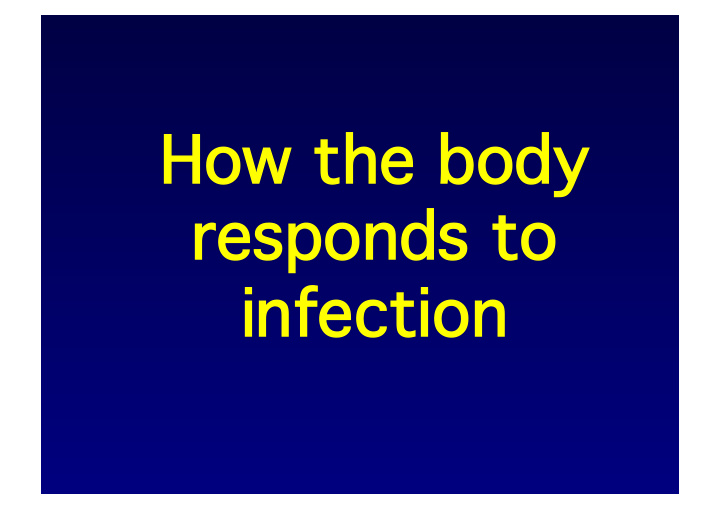



How the body How the body responds to responds to infection infection
Primary lymphoid organs
Infectious agents Infectious agents • Viruses Viruses • Bacteria Bacteria • Fungi Fungi • Protozoa Protozoa • Worms Worms
Neutrophils Eosinophils PMN/ Basophils Granulocytes Mast cells Myeloid Monocytes/ Macrophages Dendritic cells Mononuclear cells NK cells Lymphoid CD8 + Tc lymphocytes CD4 + Th lymphocytes B lymphocytes
Anti-microbial • Antibodies / immunoglobulins (IgM, IgG, IgA, IgE, IgD) • Pentraxins (eg. C-reactive protein) • Collectins (eg. mannan-binding lectin) • Complement proteins • Defensins • Lytic enzymes • Interferons • Cytotoxins (perforins, granzymes) Regulatory / inflammatory • Cytokines (eg. interleukins, interferons, tumour necrosis factors) • Chemokines • Prostaglandins, leukotrienes, etc. (products of arachidonic acid) • Histamine
Neutrophils Eosinophils PMN/ Basophils Granulocytes Mast cells Myeloid Innate Monocytes/ Macrophages Dendritic cells Mononuclear cells NK cells Lymphoid CD8 + Tc lymphocytes CD4 + Th lymphocytes Adaptive B lymphocytes
eg. eg. macrophages macrophages PRR PRR PAMP PAMP
eg. eg. Antigen Antigen B lymphocytes B lymphocytes receptor receptor Antigen Antigen
Stages of a primary immune response. 1) Epithelial barrier. 2) Immediate local response (innate): complement proteins macrophages 3) Early induced response (innate/ inflammatory): inflammatory mediators from complement, macrophages, mast cells - attract leucocytes and serum proteins (more complement)
4) Later adaptive response: antigen carriage by dendritic cells to lymphoid tissue activation of specific T and B lymphocytes and Ab production recirculation to site of infection Following primary infection: - Memory T and B cells give faster and bigger responses on second exposure to the same infection (in stage 4 above).
Allergic rhinitis - Allergic rhinitis - eg eg. . hayfever hayfever
Contact dermatitis - Contact dermatitis - eg eg. nickel allergy . nickel allergy
Autoimmune Autoimmune thyroiditis thyroiditis
Rheumatoid arthritis Rheumatoid arthritis
Recommend
More recommend